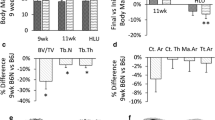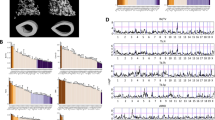Abstract
Quantitative trait locus analysis can be used to identify genes critically involved in biological processes. No such analysis has been applied to identifying genes that control bone fracture healing. To determine the feasibility of such an approach, healing of femur fractures was measured between C57BL/6, DBA/2, and C3H inbred strains of mice. Healing was assessed by radiography and histology and measured by histomorphometry and biomechanical testing. In all strains, radiographic bridging of the fracture was apparent after 3 weeks of healing. Histology showed that healing occurred through endochondral ossification in all strains. Histomorphometric measurements found more bone in the C57BL/6 fracture calluses 7 and 10 days after fracture. In contrast, more cartilage was present after 7 days in the C3H callus, which rapidly declined to levels less than those of C57BL/6 or DBA/2 mice by 14 days after fracture. An endochondral ossification index was calculated by multiplying the callus percent cartilage and bone areas as a measure of endochondral ossification. At 7 and 10 days after fracture, this value was higher in C57BL/6 mice. Using torsional mechanical testing, normalized structural and material properties of the C57BL/6 healing femurs were higher than values from the DBA/2 or C3H mice 4 weeks after fracture. The data indicate that fracture healing proceeds more rapidly in C57BL/6 mice and demonstrate that genetic variability significantly contributes to the process of bone regeneration. Large enough differences exist between C57BL/6 and DBA/2 or C3H mice to permit a quantitative trait locus analysis to identify genes controlling bone regeneration.




Similar content being viewed by others
References
Gerstenfeld LC, Cullinane DM, Barnes GL, Graves DT, Einhorn TA (2003) Fracture healing as a post-natal developmental process: molecular, spatial, and temporal aspects of its regulation. J Cell Biochem 88:873–884
Simon AM, Manigrasso MB, O’Connor JP (2002) Cyclo-oxygenase 2 function is essential for bone fracture healing. J Bone Miner Res 17:963–976
Simon AM, O’Connor JP (2007) Dose and time-dependent effects of cyclooxygenase-2 inhibition on fracture-healing. J Bone Joint Surg Am 89:500–511
Gerstenfeld LC, Cho TJ, Kon T, Aizawa T, Tsay A, Fitch J, Barnes GL, Graves DT, Einhorn TA (2003) Impaired fracture healing in the absence of TNF-alpha signaling: the role of TNF-alpha in endochondral cartilage resorption. J Bone Miner Res 18:1584–1592
Hausman MR, Schaffler MB, Majeska RJ (2001) Prevention of fracture healing in rats by an inhibitor of angiogenesis. Bone 29:560–564
Maes C, Carmeliet P, Moermans K, Stockmans I, Smets N, Collen D, Bouillon R, Carmeliet G (2002) Impaired angiogenesis and endochondral bone formation in mice lacking the vascular endothelial growth factor isoforms VEGF164 and VEGF188. Mech Dev 111:61–73
Lander ES, Botstein D (1989) Mapping mendelian factors underlying quantitative traits using RFLP linkage maps. Genetics 121:185–199
Beamer WG, Donahue LR, Rosen CJ, Baylink DJ (1996) Genetic variability in adult bone density among inbred strains of mice. Bone 18:397–403
Bak B, Andreassen TT (1989) The effect of aging on fracture healing in the rat. Calcif Tissue Int 45:292–297
Meyer RA Jr, Tsahakis PJ, Martin DF, Banks DM, Harrow ME, Kiebzak GM (2001) Age and ovariectomy impair both the normalization of mechanical properties and the accretion of mineral by the fracture callus in rats. J Orthop Res 19:428–435
Lu C, Miclau T, Hu D, Hansen E, Tsui K, Puttlitz C, Marcucio RS (2005) Cellular basis for age-related changes in fracture repair. J Orthop Res 23:1300–1307
Manigrasso MB, O’Connor JP (2004) Characterization of a closed femur fracture model in mice. J Orthop Trauma 18:687–695
Baron R, Vigney A, Neff L, Silvergate A, Santa Maria A (1983) Processing of undecalcified bone specimens for bone histomorphometry. In: Recker RR (ed) Bone histomorphometry: techniques and interpretation. CRC Press, Boca Raton, FL, pp 13–35
Maniatopoulos C, Rodriguez A, Deporter DA, Melcher AH (1986) An improved method for preparing histological sections of metallic implants. Int J Oral Maxillofac Implants 1:31–37
Li X, Gu W, Masinde G, Hamilton-Ulland M, Xu S, Mohan S, Baylink DJ (2001) Genetic control of the rate of wound healing in mice. Heredity 86:668–674
Li X, Gu W, Masinde G, Hamilton-Ulland M, Rundle CH, Mohan S, Baylink DJ (2001) Genetic variation in bone-regenerative capacity among inbred strains of mice. Bone 29:134–140
Nagashima M, Sakai A, Uchida S, Tanaka S, Tanaka M, Nakamura T (2005) Bisphosphonate (YM529) delays the repair of cortical bone defect after drill-hole injury by reducing terminal differentiation of osteoblasts in the mouse femur. Bone 36:502–511
Chiba S, Okada K, Lee K, Segre GV, Neer RM (2001) Molecular analysis of defect healing in rat diaphyseal bone. J Vet Med Sci 63:603–608
Rajnoch C, Ferguson S, Metcalfe AD, Herrick SE, Willis HS, Ferguson MW (2003) Regeneration of the ear after wounding in different mouse strains is dependent on the severity of wound trauma. Dev Dyn 226:388–397
Sheng MH, Lau KH, Mohan S, Baylink DJ, Wergedal JE (2006) High osteoblastic activity in C3H/HeJ mice compared to C57BL/6J mice is associated with low apoptosis in C3H/HeJ osteoblasts. Calcif Tissue Int 78:293–301
Panjabi MM, Lindsey RW, Walter SD, White AA III (1989) The clinician’s ability to evaluate the strength of healing fractures from plain radiographs. J Orthop Trauma 3:29–32
Blokhuis TJ, de Bruine JH, Bramer JA, den Boer FC, Bakker FC, Patka P, Haarman HJ, Manoliu RA (2001) The reliability of plain radiography in experimental fracture healing. Skeletal Radiol 30:151–156
de Boer J, van Blitterswijk C, Lowik C (2006) Bioluminescent imaging: emerging technology for non-invasive imaging of bone tissue engineering. Biomaterials 27:1851–1858
Iris B, Zilberman Y, Zeira E, Galun E, Honigman A, Turgeman G, Clemens T, Gazit Z, Gazit D (2003) Molecular imaging of the skeleton: quantitative real-time bioluminescence monitoring gene expression in bone repair and development. J Bone Miner Res 18:570–578
Yang M, Baranov E, Jiang P, Sun FX, Li XM, Li L, Hasegawa S, Bouvet M, Al-Tuwaijri M, Chishima T, Shimada H, Moossa AR, Penman S, Hoffman RM (2000) Whole-body optical imaging of green fluorescent protein-expressing tumors and metastases. Proc Natl Acad Sci USA 97:1206–1211
Yang M, Li L, Jiang P, Moossa AR, Penman S, Hoffman RM (2003) Dual-color fluorescence imaging distinguishes tumor cells from induced host angiogenic vessels and stromal cells. Proc Natl Acad Sci USA 100:14259–14262
Zaheer A, Lenkinski RE, Mahmood A, Jones AG, Cantley LC, Frangioni JV (2001) In vivo near-infrared fluorescence imaging of osteoblastic activity. Nat Biotechnol 19:1148–1154
Kozloff KM, Weissleder R, Mahmood U (2007) Noninvasive optical detection of bone mineral. J Bone Miner Res 22:1208–1216
Cheung KM, Kaluarachi K, Andrew G, Lu W, Chan D, Cheah KS (2003) An externally fixed femoral fracture model for mice. J Orthop Res 21:685–690
Connolly CK, Li G, Bunn JR, Mushipe M, Dickson GR, Marsh DR (2003) A reliable externally fixated murine femoral fracture model that accounts for variation in movement between animals. J Orthop Res 21:843–849
Author information
Authors and Affiliations
Corresponding author
Rights and permissions
About this article
Cite this article
Manigrasso, M.B., O’Connor, J.P. Comparison of Fracture Healing Among Different Inbred Mouse Strains. Calcif Tissue Int 82, 465–474 (2008). https://doi.org/10.1007/s00223-008-9144-3
Received:
Accepted:
Published:
Issue Date:
DOI: https://doi.org/10.1007/s00223-008-9144-3




